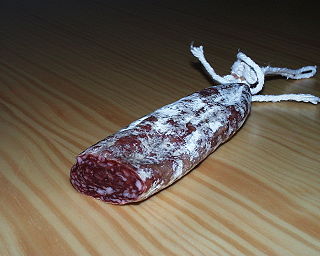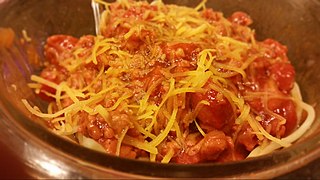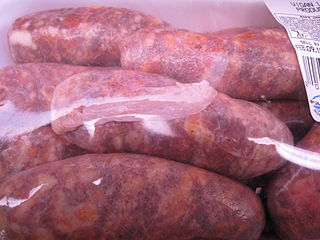
Sausages are a meat product usually made from ground meat, often pork, beef, or poultry, along with salt, spices and other flavourings. Other ingredients such as grains or breadcrumbs may be included as fillers or extenders. Some sausages include other ingredients for flavour.

Chorizo or chouriço is a type of pork sausage.

Longaniza is a Spanish sausage (embutido) similar to a chorizo and also closely associated with the Portuguese linguiça. Its defining characteristics are interpreted differently from region to region. It is popular in the cuisines of several regions of Spain, Argentina, Uruguay, Puerto Rico, Dominican Republic, El Salvador, Mexico and Chile. In the Philippines, it is called longganisa and differs greatly with hundreds of variants with different vernacular tastes and forms due to the 144 ethno-linguistic groups in the archipelago.

Hamonado is a Filipino dish consisting of meat marinated and cooked in a sweet pineapple sauce. It is a popular dish during Christmas in Philippine regions where pineapples are commonly grown. Hamonado is also a general term for savory dishes marinated or cooked with pineapple in the Philippines.

Embutido or embotido, is a Philippine meatloaf made with ground pork and stuffed with hard-boiled eggs and sliced ham or various sausages. It is traditionally wrapped in aluminum foil and steamed, though it can also be baked.

Morcón is a Philippine braised beef roulade made with beef flank steak stuffed with hard-boiled eggs, carrots, pickled cucumber, cheese, and various sausages. It is commonly served during Christmas and other festive occasions.

Filipino spaghetti is a Filipino adaptation of the Italian spaghetti with Bolognese sauce. It has a distinctively sweet sauce, usually made from tomato sauce sweetened with brown sugar or banana ketchup. It is typically topped with sliced hotdogs or smoked longganisa sausages, giniling, and grated cheese. It is regarded as a comfort food in Philippine cuisine. It is typically served in almost any special occasion, especially on children's birthdays.
Alaminos longganisa, also known as longganisa Pangasian, is a Filipino pork sausage originating from Alaminos City, Pangasinan. It is a type of de recadolongganisa. It is made with ground lean pork, ground pork fat, brown sugar, coarse salt, saltpeter, black pepper, vinegar, and garlic in hog casings. It is typically bright yellow or orange due to the use of achuete seeds. The segments of the sausage are uniquely divided by small pieces of coconut leaf midribs. Each sausage string usually has six segments and is traditionally tied at the end with a length of buli palm fiber. The sausages are celebrated in an annual "Longganisa Festival" in Alaminos City.

Vigan longganisa, also known as the Ilocano longganisa, is a Filipino pork sausage originating from Vigan City, Ilocos Sur. It is a type of de recadolongganisa. It is made with ground lean pork, ground pork fat, brown sugar, garlic, onions, bay leaves, soy sauce, vinegar, black pepper, and salt to taste in hog casings. Chili flakes may also be added. The sausages are celebrated in an annual "Longganisa Festival" in Vigan City.
Chorizo de Macao, sometimes called Chinese Chorizo or Longaniza Macau, is a Filipino dry pork sausage. It is native to the Philippines and does not originate from Macau or China, despite the name. The ingredients of Chorizo de Macao is identical to other Filipino sweet longganisas, except for its dry texture and its use of star anise, aniseed, or anise liqueur (anisado), which gives it its distinctive aroma and its name. It is commonly used in Chinese Filipino dishes like pancit Canton and siopao. It is sometimes confused with and used in place of Chinese sausage.

Chorizo de Cebu, also known as longganisa de Cebu, is a Filipino pork sausage originating from Cebu, Philippines. It is a type of hamonada (sweet) longganisa. They are distinctively red in color due to the use of achuete seeds. Each link is also usually spherical in shape. It is made from ground lean pork, ground pork fat, salt, saltpeter, sugar, anise liqueur (anisado), paprika, black pepper, garlic, and chilis to taste in a hog casing. It can also be made without the casing. They are usually fried or grilled and eaten with white rice, puso, or garlic rice for breakfast.
Chorizo negrense, also known as chorizo de Bacólod, is a Filipino smoked pork sausage originating from Bacolod, Negros. It comes in two flavors: hamonado (sweet) and recado (garlicky). It can be prepared smoked in a casing, or prepared fresh without the casing. It is made with ground pork, vinegar, garlic, calamansi, soy sauce, black pepper, and coarse salt. Sugar is added to the hamonado version.
Longganisa de Guinobatan is a Filipino pork sausage originating from the town of Guinobatan in Albay, Philippines. It is a type of de recadolongganisa. Each link is typically only 2 inches (5.1 cm) in length. It is made from lean pork, pork fat, salt, sugar, garlic, saltpeter, and black pepper. Unlike other Philippine sausages, the meat is uniquely chopped by hand. The dish is celebrated in the annual "Longganisa Festival" of Guinobatan.

Calumpit longganisa, also known as longganisang bawang, is a Filipino pork sausage originating from Calumpit, Bulacan, Philippines. It is a type of de recadolongganisa. It is made with lean pork, pork fat, garlic, bay leaves, brown sugar, soy sauce, vinegar, salt, black pepper, paprika, and optionally, chili.

Lucban longganisa is a Filipino pork sausage originating from Lucban, Quezon. It is a type of de recadolongganisa. It is characterized by its use of oregano and its garlicky and sour taste. It is made with lean pork, pork fat, coarse salt, garlic, oregano, paprika, sugar, and vinegar. It can be prepared with or without the casing.
Tuguegarao longganisa, also known as the Ybanag longganisa, is a Filipino pork sausage originating from the Ybanag people of Tuguegarao City, Cagayan. It is a type of de recadolongganisa. It is made with coarsely ground pork, black pepper, garlic, coarse salt, and cane vinegar in hog casings. It is typically dyed orange with achuete oil.

Guagua longganisa, also known as Candaba longganisa, is a Filipino pork sausage originating from the towns of Guagua and Candaba, Pampanga. It is a type of de recadolongganisa characterized by its salty and sour taste because of its heavier use of vinegar in comparison to other Filipino sausages.
Fish longganisa or fish chorizo, is a Filipino sausage made with fish instead of pork or beef. It is typically made from tuna, tilapia, or milkfish. It is prepared identically to other Filipino longganisa and is marketed as a healthier alternative. It may use regular pork casings, vegetable-based casings, or are prepared "skinless".
Baguio longganisa is a Filipino pork sausage originating from the city of Baguio. It is a type of hamonado (sweet) longganisa.













